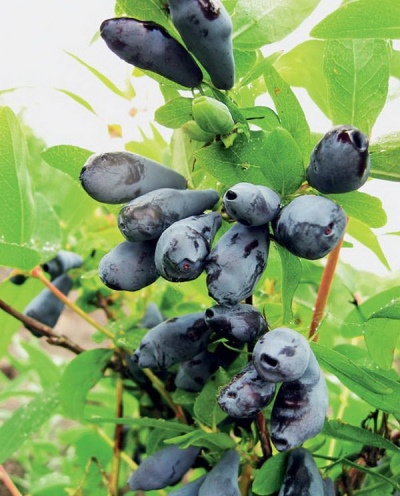
- Authors: A.K. Skvortsov, A.G. Kuklina (Main Botanical Garden named after N.V. Tsitsin RAS)
- Year of approval: 1998
- Growth type: vigorous
- Description of the bush: medium spreading
- Bush height, m: 1,9
- Escapes: pubescent, light brown, no thorns
- Leaves: oval, medium, green, strongly pubescent, matte
- Crown: broadly round, densely branched
- Flowers: medium, light yellow, two-flowered inflorescence
- Fruit weight, g: 0,8
The Moskovskaya 23 variety is considered one of the best early varieties. It is adapted for growing in the temperate climate of the middle zone. Berries are consumed fresh and used for processing, they contain a large amount of vitamin C.
Breeding history
The variety appeared in the Main Botanical Garden named after N.V. Tsitsin of the Russian Academy of Sciences with the participation of breeders A.K. Skvortsov, A.G. Kuklin. Produced by free pollination of edible blue honeysuckle species. Included in the State Register in 1998.
Description of the variety
The bush is medium-sized, up to 1.9 m high, not very sprawling, with a rounded dense crown. Branches are short, curved, young shoots are light brown, pubescent. Leaves are oval, medium-sized, pubescent. Flowers are light yellow, collected in inflorescences of 2 pcs. Moskovskaya 23 is resistant to re-flowering in September-October. The plant has a high growth rate.
Fruit characteristics
Berries of medium size, weighing up to 0.8 g, pear-shaped, sometimes turning into oval, with a bumpy surface, the color is dark blue, sometimes even black. The skin is thin with a waxy coating, the pulp is tender with a strong aroma. Fruits are stored for about 3 days in the refrigerator.
Taste qualities
The taste is sweet and sour; with a lack of moisture, bitterness may appear. Sugar content - 5.3%, acid - 2.7%, ascorbic acid - 59.4 mg per 100 g. Tasting score 4.1 points.
Ripening and fruiting
The bush begins to bear fruit 4-5 years after planting. The ripening period is early, the harvest begins to ripen in the first half of June, but the ripening is uneven. Ripe berries hang on the branches for no more than a week, they are recommended to be picked every 2-3 days.
Yield
2-4 kg are removed from one bush.

Growing regions
The culture is suitable for cultivation throughout Russia.
Self-fertility and the need for pollinators
A self-fertile variety, for a high yield, varieties are required: Titmouse, Fortuna, Nymph, Blue Bird, Viola, Blue Spindle, Amphora, Malvina.
Growing and care
Moskovskaya 23 is considered an unpretentious species, undemanding to growing conditions. This is ideal for a small garden. Usually, 2 other types of honeysuckle are planted nearby, using a 1.5x1.5 m scheme.
Bushes are planted in late summer, in August, or in autumn, until mid-October. Before planting in loamy soils, sand and peat must be added, in poor soils - organic fertilizers. A hole is dug with a diameter of 25 cm, a depth of 30 cm. Warm water is poured into it 2 hours before planting. Pour garden soil mixed with 10 kg of humus, 300 g of ash, 100 g of superphosphate and 30 g of potassium sulfate on top. A seedling is placed on top, the roots are straightened, and the root collar is deepened by 3-4 cm. After planting, the seedlings are watered with 10 liters of water, mulched with humus and straw. Near the seedlings, the soil is kept moist.Adult shrubs are watered about 7 times per season, in dry seasons - 14-15 times. At one time, approximately 15 liters of water are poured. Watering is not carried out during the rainy season.
The soil is loosened and weeds are removed only under young bushes; in adult plants, the roots rise to the surface, and when loosening them, they can be damaged. The best protection against weeds is a layer of hay and straw mulch.
Honeysuckle is fed with organic fertilizers only once every 3 years: 5-7 kg under a bush. In the fall, fertilize with potash and phosphorus compositions - 15 g per 1 sq. m.
In the third year of life, they begin to form a crown, they do it in the fall when the air temperature drops to -3 degrees. All branches are removed, leaving 4-5 strongest ones. Be sure to cut out the root growth.
Small dry shoots are cut annually in autumn and spring. Every 3 years it is necessary to thin out the crown, removing old unpromising branches. In shrubs over 7 years old, branches of the lower tier are cut out, which lie on the ground and interfere with getting close.
Very old plants are cut into a stump, leaving trunks 50 cm high.


Disease and pest resistance
The variety is distinguished by high resistance to diseases and pest attacks. May be affected by reddish-olive spot or powdery mildew during rainy periods. For prevention, they are treated in April and at the end of October with Bordeaux liquid. In case of a disease, the preparations "Skor", "Hom" are used. It has good immunity to mosaic and mottling. Of insects, aphids, honeysuckle miner, sawfly, false scutellum, leafworm, honeysuckle moth, tick can attack. From them, effective means "Confidor", "Decis".

Winter hardiness and the need for shelter
The culture has good winter hardiness: it can withstand temperatures up to -40 degrees. It tolerates short-term droughts well.
Location and soil requirements
The shrub requires slightly acidic and neutral substrates. Clay and loamy soils with groundwater no closer than 1.5 meters from the surface are suitable. The place is chosen open and sunny, protected from the wind. Very dry or swampy areas are unsuitable for the plant.

Review overview
The variety is liked by gardeners for regular fruiting and undemanding care: it is only watered and mulched. The berries are tasty, but with a pleasant sourness; to obtain a harvest, another variety of honeysuckle is planted next to it.































































